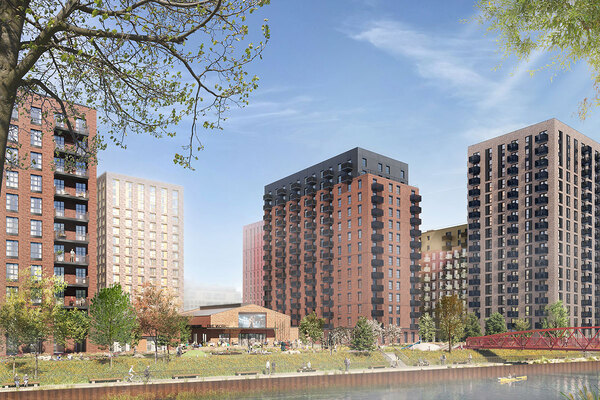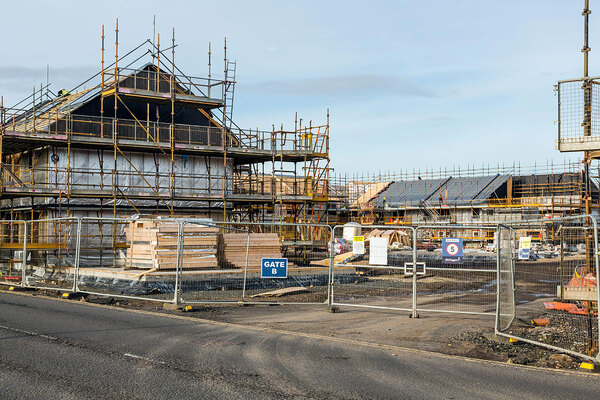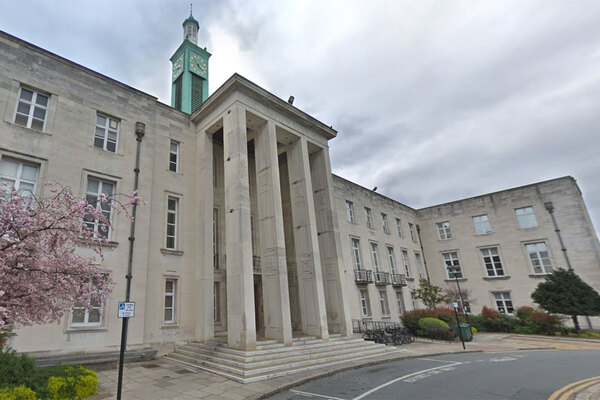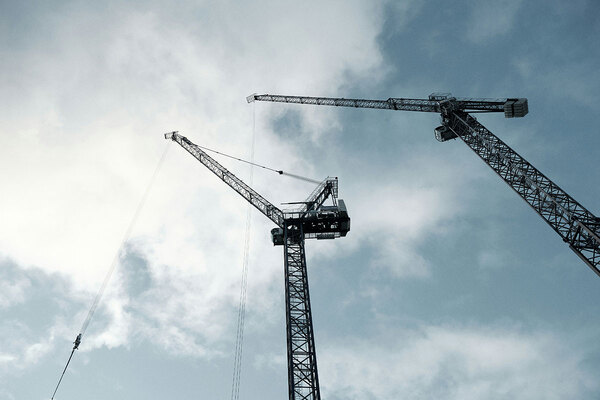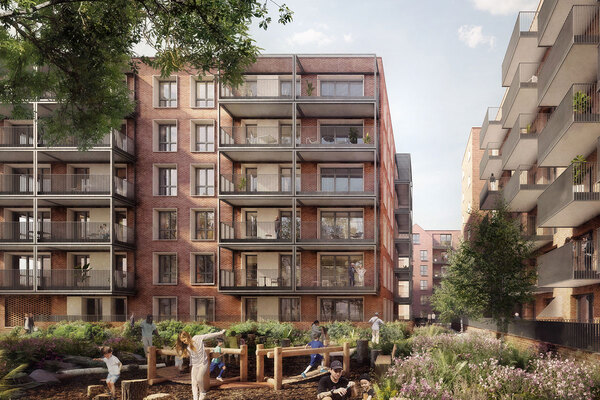In the frame
Calls for a review of the fire risks posed by timber frame buildings have reignited fears over the safety and suitability of the construction method in social housing. Caroline Thorpe reports on the facts and figures fanning the flames of the debate

‘The trouble with fire is that it doesn’t happen very often, but when it does it’s catastrophic,’ says Iain Cox. He should know. As chief fire officer of the Royal Berkshire fire and rescue service, Mr Cox sent crews to tackle more than 5,000 blazes last year. And it’s a truth that social landlords are increasingly having to learn the hard way.
As Inside Housing’s Safe as Houses campaign highlighted, there has been a worrying number of major fires in social homes in recent years. But one type of fire is causing particular concern - those that break out in properties constructed using timber frames.
Fears about the risks posed by timber frame buildings, inhabited and under construction, have grown to the extent that, three weeks ago, the Chief Fire Officers Association called for an urgent review into the regulations governing their construction. The move follows increasingly regular warnings from fire and construction experts that more should be done to address fire risk in timber frame buildings, with some even questioning the wisdom of continuing to build with timber at all.
The warnings peaked last month following a blaze in Basingstoke, Hampshire, which not only destroyed an £11.2 million timber frame development owned by housing association Saxon Weald but also damaged neighbouring buildings. ‘My argument is: is this a suitable form of construction?’ asks independent architect and fire safety expert Sam Webb.
Risky business?
It’s a debate social landlords cannot afford to ignore. One in four new homes in the UK is timber frame, according to industry body the UK Timber Frame Association. In Scotland, three quarters of all new homes are built using this method. That means about 38,000 timber frame homes were built in the UK last year, up to 8,500 of them by councils and housing associations.
Unsurprisingly the UKTFA, which represents more than 85 per cent of the country’s timber frame manufacturers, is at pains to defend the material’s fire safety credentials.
‘The environmental benefits of timber frame construction far outweigh the manageable risk of fire,’ says Dave Berry, the association’s fire consultant. Indeed the latest government data, published in the Fire Statistics Monitor in August, reveal that fire officers attended 802 timber frame fires in 2009/10 from a total of 61,000 building fires overall - hardly an overwhelming proportion.
However, the same report contains statistics that might make social landlords think twice. First, it shows that timber frame construction sites are more likely to catch fire than sites for buildings of no special construction. The main reason is that timber frame buildings are not fire-proofed until construction is complete. Plus timber is, by nature, more flammable than materials such as steel or concrete.
Second, it reveals that fires in timber frame dwellings under construction are more than seven times more likely to be in the top three most damaging categories of fire (causing between 101 and 500 square metres of damage) than fires in non-timber dwellings under construction.
Similarly, fires in existing timber frame dwellings tend to be bigger and more damaging than fires in buildings of no special construction. Again, this is largely because wood likes to burn but also because it is easier for residents to unwittingly void the fire safety features of their property when they make alterations to it, compared with a non-timber frame building. The dilemma landlords are left grappling with is simple: is timber frame safe?
The government, it seems, has not yet decided. ‘We are aware of the questions raised about timber frame buildings,’ says fire minister Bob Neill.
‘The new government will work with industry to establish whether there is evidence of specific risks associated with timber frame. We are also actively awaiting a London Assembly report on this issue.’
Even landlords that have built with timber frame in the past are uncertain - including some of those whose sites have been destroyed by fire.
‘Saxon Weald is undertaking a review of its procurement strategy,’ says Mark Crosby, business development director at the 5,000-home association. ‘This will include decisions around the use of various commonly used construction systems in the sector, including timber frame. The results of the [ongoing] investigation into the fire at Basingstoke will clearly help inform that review.’
Moat, which has a number of timber frame developments, admits the jury is out on timber frame.
‘Currently opinion is divided on the wider question of timber framing,’ says spokesperson Jodi Knight, adding that Moat’s timber frame properties comply with UK building regulations.
She says that while Moat has made no decision as to whether or not it will build with timber frame in future, ‘we are watching the situation very closely like everyone else’.
Benefits
There are good reasons for landlords to consider keeping timber frame manufacturers on their list of suppliers, according to John Thornhill, senior policy and practice officer at the Chartered Institute of Housing. He says that choosing timber frame can ‘speed up housing delivery, facilitate good design and build standards and, it has been argued, is more environmentally sustainable’.
Together with the West Midlands Fire Service and CFOA, Mr Thornhill has written a best practice brief for housing providers that the CIH will publish next month. He sees no reason not to build with timber frame - but it is crucial that appropriate safety measures must be followed. ‘If they are built according to the building regulations and if appropriate fire-retardant measures are put in place in a timber frame building, there is no reason why it should be any more or less safe than a non-timber frame building.’
Sounds easy enough: follow building regulations and landlords can continue with timber frame developments with peace of mind. The trouble is, not everyone is giving the rulebook their full attention - hence the CFOA’s recent call for its review.
‘We are not calling for new fire regulations,’ explains Royal Berkshire’s Mr Cox, who is also a CFOA director. What the association would like to see are greater efforts to ensure the existing rules are followed properly.
Specifically, Mr Cox says, full compliance with building regulation 16B would reduce the risk of timber frame fires significantly. This rule requires a building’s fire safety design to be passed from architect, to developer, to occupier. ‘16B exists, but is not being followed,’ he says.
The oversight means fire risk assessors, who check that buildings meet fire safety requirements, are also being left out of the information loop. As a result, they cannot accurately assess the safety of existing timber frame homes, explains Mr Cox. ‘How can you if you don’t know how the building is supposed to work in a fire? You can allow things to go on that you shouldn’t. Unless you [incorporate a] fire stop [where you’ve made alterations] in the way the architect intended you’ve just breached the fire wall. It’s not rocket science but we do need this information flow.’
To minimise risk, he advises landlords to study 16B and the fire design criteria of your buildings and ‘make sure nobody does any work that compromises that’. The CIH’s Mr Thornhill has put together a checklist to help landlords minimise the risk of fire in existing properties.
Secure sites
Vigilance when it comes to adhering to the building regulations will also reduce the fire risk to timber frame construction sites. But landlords should take further practical steps to increase safety. Chief of these is securing the site. While there is insufficient data to be certain, it is thought an overwhelming majority of site fires are the work of arsonists.
‘Security really needs to reflect the socio-economic environment,’ says Peter Jackman, chair and technical director of International Fire Consultants. ‘You need a totally different level if you’re building in a town centre than, say, in rural Sussex.’
His company began offering timber frame site fire risk inspections four years ago after flames destroyed a block of flats in Colindale. ‘One of the people who took us up was developing a site close to a petrol station - they really saw themselves as having to get it right.’ He reveals that IFC has carried out less than 10 such inspections since 2006 - if he had more custom, perhaps the story would be different.
Mr Cox also suggests landlords consider installing sprinklers or drenchers on timber frame sites, especially if they are close to other buildings. ‘We’re not trying to drive builders out of business, but it’s becoming increasingly apparent that this is a real risk,’ he says. ‘It takes management. It’s a pain but it just takes appropriate levels of common sense.’
Finally, perhaps the most common sense - and often overlooked - measure of all is to let residents know they are living in a timber frame home, and ensure they know what to do if a fire happens. ‘There needs to be a clear plan of what to do in an emergency,’ says Mr Thornhill. ‘Just as crucial is to ensure the safety procedures are communicated to all residents.’
When it comes to fire there can be no guarantees - timber frame construction or otherwise. It is becoming clearer how landlords can mitigate the risk to timber frame sites and homes. The shame is that it has taken so much destruction to reach this point. The hope now must be that the housing and construction industries alike are paying heed.
English fire statistics 2009/10
802
number of timber frame fires attended by fire and rescue services
1.7 per cent
of fires in buildings not under construction were in timber frame premises
12.5 per cent
of fires in buildings under construction were on timber frame sites
9 per cent
of fires in timber frame dwellings under construction caused more than 500 square metres of fire and heat damage
0 per cent
of fires in non-timber frame dwellings under construction caused more than 500 square metres of fire and heat damage
Up in flames : major timber frame fires
September 2010
A blaze destroys an over-60s care development owned by Saxon Weald in Basingstoke, Hampshire.
August 2010
Fire breaks out at a 60-flat, four-storey high rise under construction in Glasgow.
January 2010
About 75 firefighters tackle a blaze in an unfinished, five-storey building in Camberwell, south London. About 150 local residents are evacuated.
November 2009
Fire destroys 39 homes under construction for London & Quadrant in Peckham, south London. More than 300 people are evacuated after the blaze spread to neighbouring council flats.
April 2009
A three-storey flatted development in Blackpool goes up in smoke.
May 2008
Blaze destroys at a partially built apartment block in Edinburgh.
August 2007
Fire at a Metropolitan Housing Partnership development in Hatfield destroys about 80 flats.
July 2006
A six-storey building in Colindale, north London, burns to the ground.
Minimising risk in existing timber frame homes
Identify the fire hazards within your premises: sources of ignition, fuel and oxygen such as forced air circulation or medicinal or commercial oxygen supplies.
Identify people at risk: those working in close proximity to fire hazards or alone, and vulnerable people including people with disabilities, older people and parents with children.
Evaluate, remove, reduce and protect from risk: replace highly combustible materials with less combustible ones and ensure adequate separation between combustibles and ignition sources.
Record, plan, instruct, inform and train: record the hazards and people identified and make an emergency plan, tailored to specific premises. Include the actions that need to be taken and inform key people.
Review: fire risk assessments should be up to date. Re-examine fire risk assessment every time there is a significant change to the level of risk in specific premises.
